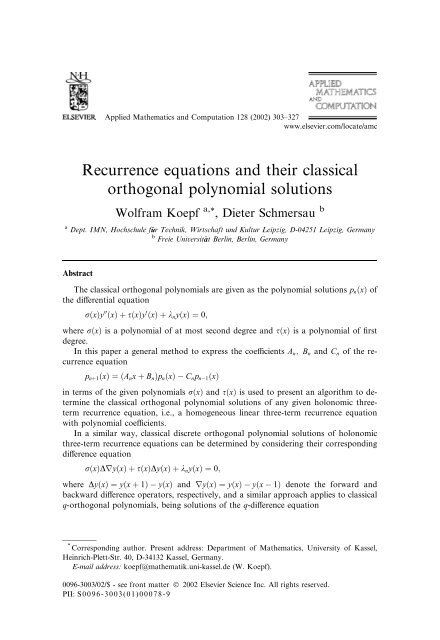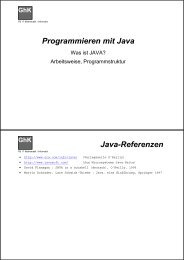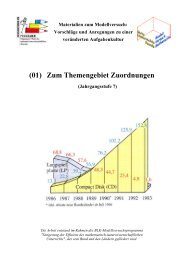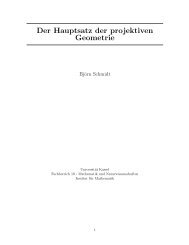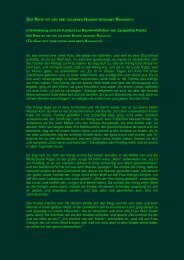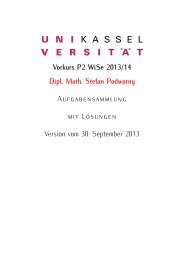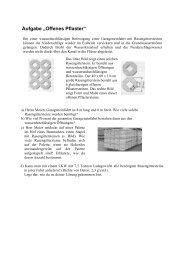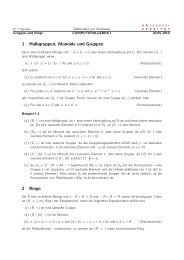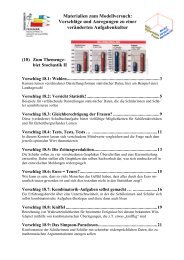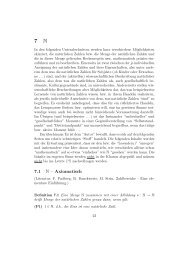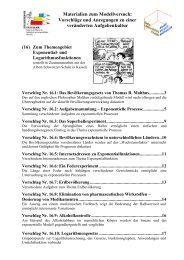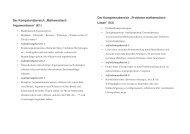Recurrence equations and their classical orthogonal polynomial ...
Recurrence equations and their classical orthogonal polynomial ...
Recurrence equations and their classical orthogonal polynomial ...
Create successful ePaper yourself
Turn your PDF publications into a flip-book with our unique Google optimized e-Paper software.
<strong>Recurrence</strong> <strong>equations</strong> <strong>and</strong> <strong>their</strong> <strong>classical</strong><br />
<strong>orthogonal</strong> <strong>polynomial</strong> solutions<br />
Wolfram Koepf a,* , Dieter Schmersau b<br />
a Dept. IMN, Hochschule f€ur Technik, Wirtschaft und Kultur Leipzig, D-04251 Leipzig, Germany<br />
b Freie Universit€at Berlin, Berlin, Germany<br />
Abstract<br />
Applied Mathematics <strong>and</strong> Computation 128 (2002) 303–327<br />
www.elsevier.com/locate/amc<br />
The <strong>classical</strong> <strong>orthogonal</strong> <strong>polynomial</strong>s are given as the <strong>polynomial</strong> solutions pnðxÞ of<br />
the differential equation<br />
rðxÞy 00 ðxÞþsðxÞy 0 ðxÞþknyðxÞ ¼0;<br />
where rðxÞ is a <strong>polynomial</strong> of at most second degree <strong>and</strong> sðxÞ is a <strong>polynomial</strong> of first<br />
degree.<br />
In this paper a general method to express the coefficients An; Bn <strong>and</strong> Cn of the recurrence<br />
equation<br />
pnþ1ðxÞ ¼ðAnxþ BnÞpnðxÞ Cnpn 1ðxÞ<br />
in terms of the given <strong>polynomial</strong>s rðxÞ <strong>and</strong> sðxÞ is used to present an algorithm to determine<br />
the <strong>classical</strong> <strong>orthogonal</strong> <strong>polynomial</strong> solutions of any given holonomic threeterm<br />
recurrence equation, i.e., a homogeneous linear three-term recurrence equation<br />
with <strong>polynomial</strong> coefficients.<br />
In a similar way, <strong>classical</strong> discrete <strong>orthogonal</strong> <strong>polynomial</strong> solutions of holonomic<br />
three-term recurrence <strong>equations</strong> can be determined by considering <strong>their</strong> corresponding<br />
difference equation<br />
rðxÞDryðxÞþsðxÞDyðxÞþknyðxÞ ¼0;<br />
where DyðxÞ ¼yðx þ 1Þ yðxÞ <strong>and</strong> ryðxÞ ¼yðxÞ yðx 1Þ denote the forward <strong>and</strong><br />
backward difference operators, respectively, <strong>and</strong> a similar approach applies to <strong>classical</strong><br />
q-<strong>orthogonal</strong> <strong>polynomial</strong>s, being solutions of the q-difference equation<br />
*<br />
Corresponding author. Present address: Department of Mathematics, University of Kassel,<br />
Heinrich-Plett-Str. 40, D-34132 Kassel, Germany.<br />
E-mail address: koepf@mathematik.uni-kassel.de (W. Koepf).<br />
0096-3003/02/$ - see front matter Ó 2002 Elsevier Science Inc. All rights reserved.<br />
PII: S0096-3003(01)00078-9
304 W. Koepf, D. Schmersau / Appl. Math. Comput. 128 (2002) 303–327<br />
rðxÞDqD1=qyðxÞþsðxÞDqyðxÞþkq;nyðxÞ ¼0;<br />
where<br />
f ðqxÞ f ðxÞ<br />
Dqf ðxÞ ¼ ; q 6¼ 1;<br />
ðq 1Þx<br />
denotes the q-difference operator. Ó 2002 Elsevier Science Inc. All rights reserved.<br />
Keywords: Computer algebra; Maple; Differential equation; Q-difference equation; Structure<br />
formula<br />
1. Introduction<br />
Families of <strong>orthogonal</strong> <strong>polynomial</strong>s pnðxÞ (corresponding to a positive-definite<br />
measure) satisfy a three-term recurrence equation of the form<br />
pnþ1ðxÞ ¼ðAnx þ BnÞpnðxÞ Cnpn 1ðxÞ ðn 2 N0; p 1 0Þ ð1Þ<br />
with CnAnAn 1 > 0, see e.g. [5, p. 20]. Moreover, Favard’s theorem states that<br />
the converse is also true.<br />
On the other h<strong>and</strong>, in practice one is often interested in an explicit solution<br />
of a given recurrence equation. Therefore it is an interesting question to ask<br />
whether a given recurrence equation has <strong>classical</strong> <strong>orthogonal</strong> <strong>polynomial</strong> solutions.<br />
In this paper an algorithm is developed which answers this question for a<br />
large class of <strong>classical</strong> <strong>orthogonal</strong> <strong>polynomial</strong> systems. Furthermore, we present<br />
results of our corresponding Maple implementation retode <strong>and</strong> compare<br />
these with the Maple implementation rec2ortho of Koornwinder <strong>and</strong><br />
Swarttouw [12]. These programs overlap, but rec2ortho does not cover<br />
Bessel, Hahn <strong>and</strong> q-<strong>polynomial</strong>s, whereas retode does not include the<br />
Meixner–Pollaczek case.<br />
2. Classical <strong>orthogonal</strong> <strong>polynomial</strong>s<br />
A family<br />
yðxÞ ¼pnðxÞ ¼knx n þ k 0<br />
n xn 1 þ ðn 2 N0 :¼ f0; 1; 2; ...g; kn 6¼ 0Þ ð2Þ<br />
of <strong>polynomial</strong>s of degree exactly n is a family of <strong>classical</strong> continuous <strong>orthogonal</strong><br />
<strong>polynomial</strong>s if it is the solution of a differential equation of the type<br />
rðxÞy 00 ðxÞþsðxÞy 0 ðxÞþknyðxÞ ¼0; ð3Þ
W. Koepf, D. Schmersau / Appl. Math. Comput. 128 (2002) 303–327 305<br />
where rðxÞ ¼ax2 þ bx þ c is a <strong>polynomial</strong> of at most second-order <strong>and</strong><br />
sðxÞ ¼dx þ e ðd 6¼ 0Þ is a <strong>polynomial</strong> of first-order ([3,13]). Since one dem<strong>and</strong>s<br />
that pnðxÞ has exact degree n, by equating the coefficients of xn in (3) one gets<br />
kn ¼ ðanðn 1ÞþdnÞ: ð4Þ<br />
Similarly, a family pnðxÞ of <strong>polynomial</strong>s of degree exactly n, given by (2), is a<br />
family of <strong>classical</strong> discrete <strong>orthogonal</strong> <strong>polynomial</strong>s if it is the solution of a<br />
difference equation of the type<br />
rðxÞDryðxÞþsðxÞDyðxÞþknyðxÞ ¼0; ð5Þ<br />
where<br />
DyðxÞ ¼yðx þ 1Þ yðxÞ <strong>and</strong> ryðxÞ ¼yðxÞ yðx 1Þ<br />
denote the forward <strong>and</strong> backward difference operators, respectively, <strong>and</strong><br />
rðxÞ ¼ax2 þ bx þ c <strong>and</strong> sðxÞ ¼dx þ e are again <strong>polynomial</strong>s of at most second<strong>and</strong><br />
of first-order, respectively, see e.g. [18]. Again, (4) follows.<br />
Finally, a family pnðxÞ of <strong>polynomial</strong>s of degree exactly n, given by (2), is a<br />
family of <strong>classical</strong> q-<strong>orthogonal</strong> <strong>polynomial</strong>s if it is the solution of a q-difference<br />
equation of the type<br />
rðxÞDqD1=qyðxÞþsðxÞDqyðxÞþkq;nyðxÞ ¼0; ð6Þ<br />
where<br />
f ðqxÞ f ðxÞ<br />
Dqf ðxÞ ¼ ; q 6¼ 1;<br />
ðq 1Þx<br />
denotes the q-difference operator [6], <strong>and</strong> rðxÞ ¼ax2 þ bx þ c <strong>and</strong> sðxÞ ¼dx þ e<br />
are again <strong>polynomial</strong>s of at most second- <strong>and</strong> of first-order, respectively. By<br />
equating the coefficients of xn in (6) one gets<br />
kq;n ¼ a½nŠ 1=q ½n 1Šq d½nŠq; ð7Þ<br />
where the abbreviation<br />
1 qn<br />
½nŠq ¼<br />
1 q<br />
denotes the so-called q-brackets. Note that limq!1½nŠq ¼ n.<br />
It can be shown (see e.g. [14]) that any solution pnðxÞ of either (3), (5) or (6)<br />
satisfies a recurrence equation (1).<br />
The following is a general procedure to find the coefficients of the recurrence<br />
equation (as well as of similar structural formulas for <strong>classical</strong> <strong>orthogonal</strong><br />
<strong>polynomial</strong>s, see [10]) in terms of the coefficients a; b; c; d <strong>and</strong> e of rðxÞ <strong>and</strong> sðxÞ:<br />
1. Substitute pnðxÞ ¼knx n þ k 0 n xn 1 þ k 00<br />
n xn 2 þ in the differential equation<br />
(3), in the difference equation (5) or in the q-difference equation (6), respectively.
306 W. Koepf, D. Schmersau / Appl. Math. Comput. 128 (2002) 303–327<br />
2. Equating the coefficients of xn yields kn, given by (4) <strong>and</strong> (7), respectively.<br />
3. Equating the coefficients of xn 1 <strong>and</strong> xn 2 gives k0 n , <strong>and</strong> k00<br />
n , respectively, as rational<br />
multiples of kn.<br />
4. Substitute pnðxÞ in the proposed equation, <strong>and</strong> equate again the three highest<br />
coefficients. In the case of the recurrence equation (1), this yields<br />
<strong>and</strong><br />
kn<br />
knþ1<br />
An ¼ 1; eBn ¼ kn<br />
eCn ¼ kn 1<br />
knþ1<br />
Cn ¼ k00<br />
n<br />
kn<br />
knþ1<br />
k 00<br />
nþ1<br />
knþ1<br />
Bn ¼ k0 nþ1<br />
knþ1<br />
k 0 n<br />
kn<br />
2<br />
k 0 n<br />
kn<br />
þ k0 n<br />
kn<br />
k 0 nþ1<br />
knþ1<br />
by linear algebra.<br />
5. Substituting the values of k0 n<br />
the three unknowns in terms of a; b; c; d; e; n; kn 1; kn, <strong>and</strong> knþ1.<br />
;<br />
<strong>and</strong> k00<br />
n given in step 3 in these <strong>equations</strong> yields<br />
With regard to the recurrence equation coefficients, we collect these results in<br />
the following theorem.<br />
Theorem 1. Let pnðxÞ ¼knx n þ ðn 2 N0Þ be a family of <strong>polynomial</strong> solutions<br />
of the differential equation (3). Then the recurrence equation (1) is valid with<br />
<strong>and</strong><br />
kn<br />
knþ1<br />
An ¼ 1; ð8Þ<br />
kn<br />
Bn ¼<br />
knþ1<br />
kn 1<br />
Cn ¼<br />
knþ1<br />
2bnðan þ d aÞ eð d þ 2aÞ<br />
ðd þ 2anÞðd 2a þ 2anÞ<br />
ðan þ d 2aÞn<br />
ðd 2a þ 2anÞ 2 ð2an 3a þ dÞð2an a þ dÞ<br />
nð4ca b 2 Þþ4a 2 c ab 2 þ ae 2<br />
4acd þ db 2<br />
ð9Þ<br />
ðan þ d 2aÞ<br />
bed þ d 2 c<br />
ð10Þ<br />
in terms of the coefficients a, b, c, d <strong>and</strong> e of the given differential equation.<br />
Let pnðxÞ ¼knx n þ ðn 2 N0Þ be a family of <strong>polynomial</strong> solutions of the<br />
difference equation (5). Then the recurrence equation (1) is valid with<br />
kn<br />
knþ1<br />
An ¼ 1;<br />
kn<br />
Bn ¼<br />
knþ1<br />
nðd þ 2bÞðd þ an aÞþeðd 2aÞ<br />
ð2an 2a þ dÞðd þ 2anÞ<br />
ð11Þ
<strong>and</strong><br />
kn 1<br />
Cn ¼<br />
knþ1<br />
ðd<br />
ðan þ d<br />
a þ 2anÞðd þ 2an<br />
2aÞn<br />
3aÞð2an 2a þ dÞ 2 ðn 1Þ<br />
ðd þ an aÞð<strong>and</strong> db ad þ a 2 n 2<br />
2a 2 n<br />
þ 4ca þ a 2 þ 2ea b 2 Þ dbe þ d 2 c þ ae 2<br />
ð12Þ<br />
in terms of the coefficients a, b, c, d <strong>and</strong> e of the given difference equation.<br />
Let pnðxÞ ¼knx n þ ðn 2 N0Þ be a family of <strong>polynomial</strong> solutions of the<br />
q-difference equation (6). Then the recurrence equation (1) is valid with<br />
kn<br />
knþ1<br />
An ¼ 1;<br />
kn<br />
b½nŠq þ eq<br />
Bn ¼½nþ 1Šq knþ1<br />
n<br />
a½2nŠq þ dq2n <strong>and</strong> (N ¼ qn )<br />
kn 1<br />
knþ1<br />
W. Koepf, D. Schmersau / Appl. Math. Comput. 128 (2002) 303–327 307<br />
½nŠ q<br />
Cn ¼ððN 1Þð Nd þ Na þ Nqd aq 2 Þ<br />
ð a 2 cN 4 N 4 d 2 c þ N 3 beqd abeNq 3<br />
n 1<br />
b½n 1Šq þ eq<br />
a½2ðn 1ÞŠq þ dq2ðn 1Þ ð13Þ<br />
2adcN 2 q 2<br />
þ 2aN 2 q 2 be aN 3 beq þ beN 3 q 3 d 2beN 3 q 2 d<br />
þ 2dcN 2 q 3 a 2beN 2 q 3 a 2dcN 4 qa þ beNq 4 a<br />
þ beN 3 aq 2<br />
b 2 q 3 dN 2<br />
a 2 cq 4 þ N 2 b 2 q 2 d N 3 b 2 qd<br />
þ aNq 3 b 2<br />
2ab 2 N 2 q 2<br />
ae 2 N 2 q 2 þ aN 3 b 2 q þ 2aN 4 dc<br />
þ 2a 2 cq 2 N 2 þ 2d 2 cN 4 q d 2 cN 4 q 2 þ b 2 N 3 q 2 d<br />
þ 2e 2 N 2 q 3 a e 2 N 2 q 4 aÞNqÞ=ððdN 2 q aq þ aN 2<br />
dN 2 Þ<br />
ðdN 2 q dN 2 þ aN 2<br />
aq 2 Þ 2 ðdN 2 q dN 2 þ aN 2<br />
aq 3 ÞÞ ð14Þ<br />
in terms of the coefficients a, b, c, d <strong>and</strong> e of the given q-difference equation.<br />
3. The inverse characterization problem<br />
It is well-known ([3], see also [4,13]) that <strong>polynomial</strong> solutions of (3) can be<br />
classified according to the zeros of rðxÞ, leading to the normal forms of Table 1<br />
besides linear transformations x 7! Ax þ B. The type of differential equation<br />
that we consider is invariant under such a transformation.<br />
This shows that the only <strong>orthogonal</strong> <strong>polynomial</strong> solutions are linear<br />
transforms of the Hermite, Laguerre, Bessel <strong>and</strong> Jacobi <strong>polynomial</strong>s (for details<br />
see e.g. [10]), hence using a mathematical dictionary one can always deduce<br />
the recurrence equation. Note, however, that this approach except than
308 W. Koepf, D. Schmersau / Appl. Math. Comput. 128 (2002) 303–327<br />
Table 1<br />
Normal forms of <strong>polynomial</strong> solutions<br />
rðxÞ sðxÞ pnðxÞ Family<br />
1 0 x xn 2 1 2x HnðxÞHermite <strong>polynomial</strong>s<br />
3 x x þ a þ 1 LðaÞ n ðxÞ Laguerre <strong>polynomial</strong>s<br />
4a x2 0 xn 4b x2 ða þ 2Þx þ 2 BðaÞ n ðxÞ Bessel <strong>polynomial</strong>s<br />
5 ðx þ 1Þðx 1Þ ðaþbþ2Þxþab P ða;bÞ<br />
n ðxÞ Jacobi <strong>polynomial</strong>s<br />
being tedious may require the work with radicals, namely the zeros of the<br />
quadratic <strong>polynomial</strong> rðxÞ, whereas our approach is completely rational: Given<br />
knþ1=kn 2 QðnÞ, the recurrence equation is given rationally by Theorem 1.<br />
Moreover, Theorem 1 represents the recurrence equation by a unique formula.<br />
It is valid also in the cases of Table 1(1) <strong>and</strong> (4a), with the trivial solution<br />
pnðxÞ ¼x n . In both cases we have the recurrence equation pnþ1ðxÞ ¼xpnðxÞ.<br />
Now, we will use the fact that these <strong>equations</strong> are given explicitly to solve an<br />
inverse problem.<br />
Assume one knows that a <strong>polynomial</strong> system satisfies a differential equation<br />
(3). Then by the classification of Table 1 it is easy to identify the system. On the<br />
other h<strong>and</strong>, given an arbitrary holonomic three-term recurrence equation<br />
qnðxÞPnþ2ðxÞþrnðxÞPnþ1ðxÞþsnðxÞPnðxÞ ¼0; ð15Þ<br />
ðqnðxÞ; rnðxÞ; snðxÞ 2Q½n; xŠÞ, it is less obvious to find out whether there is a<br />
<strong>polynomial</strong> system<br />
PnðxÞ ¼knx n þ ðn 2 N0; kn 6¼ 0Þ<br />
satisfying (15), being a linear transform of one of the <strong>classical</strong> systems<br />
(Hermite, Laguerre, Jacobi, Bessel), <strong>and</strong> to identify the system in the affirmative<br />
case. In this section we present an algorithm for this purpose. Note that<br />
Koornwinder <strong>and</strong> Swarttouw [12] have also considered this question <strong>and</strong> in<br />
<strong>their</strong> Maple implementation rec2ortho propose a solution based on the<br />
careful ad hoc analysis of the input <strong>polynomial</strong>s (actually, they start with Eq.<br />
(19)). Their Maple implementation deals with the following families: Hermite,<br />
Charlier, Laguerre, Meixner–Pollaczek, Meixner, Krawtchouk, <strong>and</strong> Jacobi.<br />
Let us start with a recurrence equation of type (15). Without loss of generality<br />
we assume that neither qn 1ðxÞ nor snðxÞ has a nonnegative integer zero w.r.t. n.<br />
Otherwise, a suitable shift can be applied, see Algorithm 1 <strong>and</strong> Example 1.<br />
Therefore, in the sequel we assume that the recurrence equation<br />
qnðxÞpnþ2ðxÞþrnðxÞpnþ1ðxÞþsnðxÞpnðxÞ ¼0; ð16Þ
ðqnðxÞ; rnðxÞ; snðxÞ 2Q½n; xŠÞ, is valid, but neither qn 1ðxÞ nor snðxÞ have nonnegative<br />
integer zeros. We search for solutions<br />
pnðxÞ ¼knx n þ k 0<br />
n xn 1 þ ðn 2 N0; kn 6¼ 0Þ: ð17Þ<br />
Next, we divide (16) by qnðxÞ, <strong>and</strong> replace n by n 1. This brings (16) into the<br />
form<br />
pnþ1ðxÞ ¼tnðxÞpnðxÞþunðxÞpn 1ðxÞ ðtnðxÞ; unðxÞ 2Qðn; xÞÞ: ð18Þ<br />
For pnðxÞ being a linear transform of a <strong>classical</strong> <strong>orthogonal</strong> system, there is a<br />
recurrence equation (1)<br />
pnþ1ðxÞ ¼ðAnx þ BnÞpnðxÞ Cnpn 1ðxÞ ðAn; Bn; Cn 2 QðnÞ; An 6¼ 0Þ; ð19Þ<br />
therefore (18) <strong>and</strong> (19) must agree. We would like to conclude that tnðxÞ ¼<br />
Anx þ Bn, <strong>and</strong> unðxÞ ¼ Cn. This follows if we can show that pnðxÞ=pn 1<br />
ðxÞ 62 Qðn; xÞ. For a proof of this assertion, see [9].<br />
Therefore we can conclude that tnðxÞ ¼Anx þ Bn, <strong>and</strong> unðxÞ ¼ Cn. Hence if<br />
(18) does not have this form, i.e., if either tnðxÞ is not linear in x or unðxÞ is not a<br />
constant with respect to x, we see that pnðxÞ cannot be a linear transform of a<br />
<strong>classical</strong> <strong>orthogonal</strong> <strong>polynomial</strong> system. In the positive case, we can assume the<br />
form (19).<br />
Since we propose solutions (17), equating the coefficients of x nþ1 in (19) we<br />
get<br />
knþ1<br />
kn<br />
¼ An ¼ vn<br />
wn<br />
ðvn; wn 2 Q½nŠÞ: ð20Þ<br />
Hence the given An ¼ vn=wn 2 QðnÞ generates the term ratio knþ1=kn. In particular<br />
kn turns out to be a hypergeometric term, (i.e., knþ1=kn is rational) <strong>and</strong> is<br />
uniquely determined by (20) up to a normalization constant k0 ¼ p0ðxÞ. Since<br />
the zeros of wn are a subset of the zeros of qn 1ðxÞ, kn is defined by (20) for all<br />
n 2 N from k0.<br />
In the next step we can eliminate the dependency of kn by generating a recurrence<br />
equation for the corresponding monic <strong>polynomial</strong>s ep nðxÞ ¼pnðxÞ=kn.<br />
For ep nðxÞ, we get by (20)<br />
with<br />
W. Koepf, D. Schmersau / Appl. Math. Comput. 128 (2002) 303–327 309<br />
ep nþ1ðxÞ ¼ x þ Bn<br />
An<br />
ep nðxÞ<br />
Cn<br />
AnAn 1<br />
eBn ¼ Bn<br />
2 QðnÞ <strong>and</strong> eCn ¼ Cn<br />
An<br />
AnAn 1<br />
ep n 1ðxÞ ¼ x þ eBn ep nðxÞ eCnep n 1ðxÞ<br />
2 QðnÞ:
310 W. Koepf, D. Schmersau / Appl. Math. Comput. 128 (2002) 303–327<br />
Then our formulas (9) <strong>and</strong> (10) read in terms of eBn <strong>and</strong> eCn<br />
<strong>and</strong><br />
eBn ¼<br />
2bnðaðn 1ÞþdÞþeðd 2aÞ<br />
ð2aðn 1ÞþdÞð2an þ dÞ<br />
ð21Þ<br />
eCn ¼<br />
ðað2n<br />
nðaðn 2ÞþdÞ<br />
1ÞþdÞðað2n 3ÞþdÞ<br />
!<br />
bðn<br />
c þ<br />
ð2aðn<br />
1Þþe<br />
ððae 2<br />
1ÞþdÞ<br />
bdÞ abðn 1ÞÞ ; ð22Þ<br />
<strong>and</strong> these are independent of kn by construction.<br />
Now we would like to deduce a; b; c; d <strong>and</strong> e from (21) <strong>and</strong> (22). Note that as<br />
soon as we have found these five values, we can apply a linear transform<br />
(according to the zeros of rðxÞ) to bring the differential equation in one of the<br />
normal forms of Table 1 which finally gives us the desired information.<br />
We can assume that eBn <strong>and</strong> eCn are in lowest terms. If the degree of either the<br />
numerator or the denominator of eBn is larger than 2, then by (21) pnðxÞ is not a<br />
<strong>classical</strong> system. Similarly, if the degree of either the numerator or the denominator<br />
of eCn is larger than 4, by (22) the same conclusion follows.<br />
Otherwise we can multiply (21) <strong>and</strong> (22) by <strong>their</strong> common denominators,<br />
<strong>and</strong> bring them therefore in <strong>polynomial</strong> form. Both resulting <strong>equations</strong> must be<br />
<strong>polynomial</strong> identities in the variable n, hence all of <strong>their</strong> coefficients must<br />
vanish. This gives a nonlinear system of <strong>equations</strong> for the unknowns a; b; c; d<br />
<strong>and</strong> e. Any solution of this system with not both a <strong>and</strong> d being zero yields a<br />
differential equation (3), <strong>and</strong> hence given such a solution one can characterize it<br />
via Table 1. Therefore our question can be resolved in this case. In particular, if<br />
one of the cases Table 1(1) or (1.4a) applies, then there are no <strong>orthogonal</strong><br />
<strong>polynomial</strong> solutions.<br />
If the nonlinear system does not have such a solution, we deduce that no<br />
such values a; b; c; d <strong>and</strong> e exist, hence no such differential equation is satisfied<br />
by pnðxÞ, implying that the system is not a linear transformation of a <strong>classical</strong><br />
<strong>orthogonal</strong> <strong>polynomial</strong> system.<br />
Hence the whole question boils down to decide whether the given nonlinear<br />
system has nontrivial solutions, <strong>and</strong> to find these solutions in the affirmative<br />
case. As a matter of fact, with Gr€obner bases methods, this question can be<br />
decided algorithmically [15–17]. Such an algorithm is implemented, e.g., in the<br />
computer algebra system REDUCE [16], <strong>and</strong> Maple’s solve comm<strong>and</strong> can<br />
also solve such a system.<br />
Note that the solution of the nonlinear system is not necessarily unique. For<br />
example, the Chebyshev <strong>polynomial</strong>s of the first <strong>and</strong> second kind TnðxÞ <strong>and</strong><br />
UnðxÞ satisfy the same recurrence equation, but a different differential equation.<br />
We will consider this example in more detail later.
If we apply this algorithm to the recurrence equation pnþ2ðxÞ xpnþ1ðxÞ of<br />
the power pnðxÞ ¼x n , it generates the complete solution set, given by Table 1(1)<br />
<strong>and</strong> (4a).<br />
The following statement summarizes the above considerations:<br />
Algorithm 1. This algorithm decides whether a given holonomic three-term<br />
recurrence equation has shifted, linear transforms of <strong>classical</strong> <strong>orthogonal</strong><br />
<strong>polynomial</strong> solutions, <strong>and</strong> returns <strong>their</strong> data if applicable.<br />
1. Input: A holonomic three-term recurrence equation<br />
qnðxÞpnþ2ðxÞþrnðxÞpnþ1ðxÞþsnðxÞpnðxÞ ¼0 ðqnðxÞ; rnðxÞ; snðxÞ 2Q½n; xŠÞ:<br />
2. Shift: Shift by<br />
N :¼ 0 if qn<br />
(<br />
1ðxÞ <strong>and</strong> snðxÞ have no nonnegative integer zero;<br />
maxfn 2 N0 j n is a zero of qn 1ðxÞ or snðxÞg þ 1 otherwise:<br />
3. Rewriting: Rewrite the recurrence equation in the form<br />
pnþ1ðxÞ ¼tnðxÞpnðxÞþunðxÞpn 1ðxÞ ðtnðxÞ; unðxÞ 2Qðn; xÞÞ:<br />
ð23Þ<br />
If either tnðxÞ is not a <strong>polynomial</strong> of degree one in x or unðxÞ is not constant<br />
with respect to x, then return ‘‘no <strong>orthogonal</strong> <strong>polynomial</strong> solution<br />
exists’’; exit.<br />
4. St<strong>and</strong>ardization: Given now An; Bn <strong>and</strong> Cn by<br />
pnþ1ðxÞ ¼ðAnxþ BnÞpnðxÞ Cnpn 1ðxÞ ðAn; Bn; Cn 2 QðnÞ; An 6¼ 0Þ;<br />
define<br />
knþ1<br />
kn<br />
:¼ An ¼ vn<br />
wn<br />
according to (20).<br />
5. Make monic: Set<br />
ðvn; wn 2 Q½nŠÞ<br />
eBn :¼ Bn<br />
2 QðnÞ <strong>and</strong> eCn :¼ Cn<br />
An<br />
AnAn 1<br />
2 QðnÞ<br />
<strong>and</strong> bring these rational functions in lowest terms. If the degree of either the<br />
numerator or the denominator of eBn is larger than 2, or if the degree of<br />
either the numerator or the denominator of e Cn is larger than 4, return ‘‘no<br />
<strong>classical</strong> <strong>orthogonal</strong> <strong>polynomial</strong> solution exists’’; exit.<br />
6. Polynomial identities: Set<br />
eBn ¼<br />
W. Koepf, D. Schmersau / Appl. Math. Comput. 128 (2002) 303–327 311<br />
2bnðaðn 1ÞþdÞþeðd 2aÞ<br />
ð2aðn 1ÞþdÞð2an þ dÞ
312 W. Koepf, D. Schmersau / Appl. Math. Comput. 128 (2002) 303–327<br />
<strong>and</strong><br />
eCn ¼<br />
ðað2n<br />
nðaðn 2ÞþdÞ<br />
1ÞþdÞðað2n 3ÞþdÞ<br />
!<br />
bðn<br />
c þ<br />
ð2aðn<br />
1Þþe<br />
ððae 2<br />
1ÞþdÞ<br />
bdÞ abðn 1ÞÞ ;<br />
using the as yet unknowns a; b; c; d <strong>and</strong> e. Multiply these identities by <strong>their</strong><br />
common denominators, <strong>and</strong> bring them therefore in <strong>polynomial</strong> form.<br />
7. Equating coefficients: Equate the coefficients of the powers of n in the two<br />
resulting <strong>equations</strong>. This results in a nonlinear system in the unknowns<br />
a; b; c; d <strong>and</strong> e. Solve this system by Gr€obner bases methods. If the system<br />
has no solution or only one with a ¼ d ¼ 0, then return ‘‘no <strong>classical</strong><br />
<strong>orthogonal</strong> <strong>polynomial</strong> solution exists’’; exit.<br />
8. Output: Return the <strong>classical</strong> <strong>orthogonal</strong> <strong>polynomial</strong> solutions of the differential<br />
<strong>equations</strong> (3) given by the solution vectors ða; b; c; d; eÞ of the last step, according<br />
to the classification of Table 1, together with the information about<br />
the st<strong>and</strong>ardization given by (20). This information includes the density<br />
qðxÞ 1<br />
¼<br />
C rðxÞ exp<br />
Z<br />
sðxÞ<br />
rðxÞ dx<br />
(see e.g. [13]), <strong>and</strong> the supporting interval through the zeros of rðxÞ. 1<br />
Remark. Assume that a given recurrence equation contains parameters. Then<br />
our implementation determines for which values of the parameters there are<br />
<strong>orthogonal</strong> <strong>polynomial</strong> solutions, by solving not only for a; b; c; d <strong>and</strong> e, but<br />
moreover for those parameters.<br />
Example 1. As a first example, we consider the recurrence equation<br />
ðn þ 2ÞPnþ2ðxÞ xðn þ 1ÞPnþ1ðxÞþnPnðxÞ ¼0:<br />
Since s0ðxÞ 0, we see that the shift pnðxÞ :¼ Pnþ1ðxÞ is necessary, i.e., N ¼ 1by<br />
(23). For pnðxÞ, we have the recurrence equation<br />
ðn þ 3Þpnþ2ðxÞ xðn þ 2Þpnþ1ðxÞþðn þ 1ÞpnðxÞ ¼0: ð24Þ<br />
In the first steps this recurrence equation is brought into the form<br />
pnþ1ðxÞ ¼<br />
n þ 1<br />
n þ 2 xpnðxÞ<br />
n<br />
n þ 2 pn 1ðxÞ;<br />
1<br />
If the zeros of rðxÞ are not real, then these <strong>orthogonal</strong> <strong>polynomial</strong>s are not positive-definite. The<br />
Bessel system is never positive-definite [2].
hence<br />
An ¼ knþ1<br />
kn<br />
<strong>and</strong> therefore<br />
¼<br />
n þ 1 vn<br />
¼ ;<br />
n þ 2 wn<br />
kn ¼ 1<br />
n þ 1 k0:<br />
Moreover, for monic ep nðxÞ ¼pnðxÞ=kn we get<br />
ep nþ1ðxÞ ¼xep nðxÞþep n 1ðxÞ;<br />
hence eBn ¼ 0<strong>and</strong> e Cn ¼ 1. The <strong>polynomial</strong> identities concerning eBn <strong>and</strong> e Cn of<br />
step 5 of the algorithm yield b ¼ 0, c ¼ 4a, <strong>and</strong> either<br />
d ¼ a; or d ¼ 2a; or d ¼ 3a:<br />
At this point we have already determined<br />
rðxÞ ¼ax 2 þ bx þ c ¼ aðx 2<br />
4Þ:<br />
Hence possible <strong>classical</strong> <strong>orthogonal</strong> <strong>polynomial</strong> solutions of (24) are defined in<br />
the interval ½ 2; 2Š.<br />
In the first of the above cases, i.e., for d ¼ a, one gets e ¼ 0 <strong>and</strong> the differential<br />
equation<br />
ðx 2<br />
W. Koepf, D. Schmersau / Appl. Math. Comput. 128 (2002) 303–327 313<br />
4Þy 00 ðxÞþxy 0 ðxÞ<br />
corresponding to the density<br />
nðn 2ÞyðxÞ ¼0 ð25Þ<br />
qðxÞ ¼<br />
1<br />
rðxÞ exp<br />
Z<br />
sðxÞ 1<br />
dx ¼ ffiffiffiffiffiffiffiffiffiffiffiffi<br />
rðxÞ 4 x2 p :<br />
The corresponding <strong>orthogonal</strong> <strong>polynomial</strong>s are multiples of translated<br />
Chebyshev <strong>polynomial</strong>s of the first kind<br />
pnðxÞ ¼knCnðxÞ ¼ p0<br />
n þ 1 CnðxÞ ¼ 2p0<br />
n þ 1 Tnðx=2Þ ðnP0Þ ð26Þ<br />
(see e.g. [1], Table 22.2, <strong>and</strong> (22.5.11); CnðxÞ are monic, but C0 ¼ 2, see also<br />
Table 22.7), hence finally<br />
PnðxÞ ¼pn 1ðxÞ ¼ 2P1<br />
n Tn 1ðx=2Þ ðnP1Þ: In the second of the above cases, i.e., for d ¼ 2a, one gets the equation<br />
a 2 ðe 2aÞðe þ 2aÞ ¼0
314 W. Koepf, D. Schmersau / Appl. Math. Comput. 128 (2002) 303–327<br />
with two possible solutions e ¼ 2a that give the differential <strong>equations</strong><br />
<strong>and</strong><br />
ðx 2<br />
ðx 2<br />
4Þy 00 ðxÞþ2ðx þ 1Þy 0 ðxÞ nðn 3ÞyðxÞ ¼0; ð27Þ<br />
4Þy 00 ðxÞþ2ðx 1Þy 0 ðxÞ nðn 3ÞyðxÞ ¼0: ð28Þ<br />
They correspond to the densities<br />
rffiffiffiffiffiffiffiffiffiffiffi<br />
4 þ x<br />
qðxÞ ¼<br />
4 x<br />
<strong>and</strong><br />
rffiffiffiffiffiffiffiffiffiffiffi<br />
4 x<br />
qðxÞ ¼ ;<br />
4 þ x<br />
respectively, hence the <strong>orthogonal</strong> <strong>polynomial</strong>s are multiples of the Jacobi<br />
ð1=2; 1=2Þ<br />
ð 1=2;1=2Þ<br />
<strong>polynomial</strong>s Pn ðx=2Þ <strong>and</strong> Pn ðx=2Þ.<br />
Finally, in the third of the above cases, i.e., for d ¼ 3a, we get again e ¼ 0<br />
<strong>and</strong><br />
ðx 2<br />
4Þy 00 ðxÞþ3xy 0 ðxÞ nðn 4ÞyðxÞ ¼0 ð29Þ<br />
corresponding to the density<br />
qðxÞ ¼<br />
1<br />
rðxÞ exp<br />
Z<br />
sðxÞ<br />
rðxÞ<br />
ffiffiffiffiffiffiffiffiffiffiffiffi<br />
dx ¼ 4 x2 p<br />
:<br />
The corresponding <strong>orthogonal</strong> <strong>polynomial</strong>s are multiples of translated<br />
Chebyshev <strong>polynomial</strong>s of the second kind<br />
pnðxÞ ¼knSnðxÞ ¼ p0<br />
n þ 1 SnðxÞ ¼ p0<br />
n þ 1 Unðx=2Þ ðn P 0Þ ð30Þ<br />
(see e.g. [1], Table 22.2, <strong>and</strong> (22.5.13); SnðxÞ are monic, see also Table 22.8),<br />
hence<br />
PnðxÞ ¼pn 1ðxÞ ¼ P1<br />
n Un 1ðx=2Þ ðn P 1Þ:<br />
We see that the recurrence equation (24) has four different (shifted) linearly<br />
transformed <strong>classical</strong> <strong>orthogonal</strong> <strong>polynomial</strong> solutions!<br />
Using our implementation, these results are obtained by<br />
> strict: ¼ true:<br />
> RE :¼ ðn þ 3Þ pðn þ 2Þ x ðn þ 2Þ pðn þ 1Þþðn þ 1Þ pðnÞ ¼0;<br />
RE :¼ ðn þ 3Þpðn þ 2Þ xðn þ 2Þpðn þ 1Þþðn þ 1ÞpðnÞ ¼0<br />
> REtoDE(RE,p(n),x);
W. Koepf, D. Schmersau / Appl. Math. Comput. 128 (2002) 303–327 315<br />
Warning: several solutions found<br />
o<br />
%1 þ 2ðx 1Þ pðn; xÞ<br />
ox<br />
pffiffiffiffiffiffiffiffiffiffi<br />
x þ 2<br />
I ¼½ 2; 2Š; qðxÞ ¼p<br />
ffiffiffiffiffiffiffiffiffiffi<br />
x 2<br />
nðn þ 1Þpðn; xÞ ¼0;<br />
;<br />
o<br />
%1 þ 2ðx þ 1Þ pðn; xÞ nðn þ 1Þpðn; xÞ ¼0;<br />
ox<br />
"<br />
pffiffiffiffiffiffiffiffiffiffi<br />
## "<br />
x 2<br />
o<br />
I ¼½ 2; 2Š; qðxÞ ¼pffiffiffiffiffiffiffiffiffiffi<br />
; %1 þ x<br />
x þ 2<br />
ox pðn; xÞ n2 ffiffiffiffiffiffiffiffiffiffiffiffi<br />
x<br />
I ¼½ 2; 2Š; qðxÞ ¼<br />
pðn; xÞ ¼0;<br />
2 p ##<br />
4<br />
;<br />
ðx 2Þðx þ 2Þ<br />
"<br />
!<br />
o<br />
%1 þ 3x pðn; xÞ nðn þ 2Þpðn; xÞ ¼0;<br />
ox<br />
I ¼½ 2; 2Š; qðxÞ ¼ ffiffiffiffiffiffiffiffiffiffiffiffi<br />
x2 #<br />
p<br />
n þ 1<br />
4 ¼<br />
n þ 2<br />
%1 :¼ ðx 2Þðx þ 2Þ<br />
o2 pðn; xÞ<br />
ox2 ; knþ1<br />
kn<br />
which gives the corresponding differential <strong>equations</strong>, the intervals <strong>and</strong> densities,<br />
as well as the term ratio knþ1=kn ¼ðn þ 1Þ=ðn þ 2Þ.<br />
With Koornwinder–Swarttouw’s rec2ortho, these results are obtained by<br />
the statements rec2orthoððn þ 2Þ=ðn þ 1Þ; 0; n=ðn þ 1ÞÞ, rec2ortho<br />
ððn þ 2Þ=ðn þ 1Þ;0;n=ðn þ 1Þ;4;0Þ, rec2orthoððn þ 2Þ=ðn þ 1Þ;0;n=ðn þ 1Þ;<br />
2; 1Þ, <strong>and</strong> rec2orthoððn þ 2Þ=ðn þ 1Þ; 0; n=ðn þ 1Þ; 2; 1Þ, respectively.<br />
Note that here the user must knowthe initial values to determine possible<br />
<strong>orthogonal</strong> <strong>polynomial</strong> solutions, whereas our approach finds all possible solutions<br />
at once.<br />
Example 2. As a second example, we consider the recurrence equation<br />
pnþ2ðxÞ ðx n 1Þpnþ1ðxÞþaðn þ 1Þ 2 pnðxÞ ¼0 ð31Þ<br />
depending on the parameter a 2 R. Here obviously the question arises whether<br />
or not there are any instances of this parameter for which there are <strong>classical</strong><br />
<strong>orthogonal</strong> <strong>polynomial</strong> solutions. In step 6 of Algorithm 1 we therefore solve<br />
also for this unknown parameter. This gives a slightly more complicated<br />
nonlinear system, with the unique solution<br />
b ¼ 2c; c ¼ c; d ¼ 4c; e ¼ 0; a ¼ 0; a ¼ 1<br />
4 :
316 W. Koepf, D. Schmersau / Appl. Math. Comput. 128 (2002) 303–327<br />
Hence the only possible value for a with <strong>classical</strong> <strong>orthogonal</strong> <strong>polynomial</strong> solutions<br />
is a ¼ 1=4, in which case one gets the differential equation<br />
x þ 1<br />
2 p00<br />
nðxÞ 2xp0 nðxÞ 2npnðxÞ<br />
with density<br />
¼0<br />
qðxÞ ¼2e 2x<br />
in the interval ½ 1=2; 1Š, corresponding to linearly transformed Laguerre<br />
<strong>polynomial</strong>s.<br />
Using our implementation, these results are obtained by<br />
> strict: ¼ false:<br />
> REtoDE(RE,p(n),x);<br />
Warning: parameters have the values,<br />
d ¼ 4c; b ¼ 2c; c ¼ c; e ¼ 0; a ¼ 0; a ¼ 1<br />
4<br />
1<br />
ð2x þ 1Þ<br />
2<br />
I ¼<br />
o2 pðn; xÞ 2x<br />
ox2 1<br />
2xÞ<br />
; 1 ; qðxÞ ¼2eð<br />
2<br />
o<br />
pðn; xÞ þ 2npðn; xÞ ¼0;<br />
@x<br />
; knþ1<br />
kn<br />
¼ 1 :<br />
With Koornwinder–Swarttouw’s rec2ortho, this result can also be obtained.<br />
On the other h<strong>and</strong>, the Bessel <strong>polynomial</strong>s are not accessible with Koornwinder–Swarttouw’s<br />
rec2ortho.<br />
4. Classical discrete <strong>orthogonal</strong> <strong>polynomial</strong>s<br />
In this section, we give similar results for <strong>classical</strong> <strong>orthogonal</strong> <strong>polynomial</strong>s<br />
of a discrete variable (see [18, Chapter 2]). The <strong>classical</strong> discrete <strong>orthogonal</strong><br />
<strong>polynomial</strong>s are given by a difference equation (5).<br />
These <strong>polynomial</strong>s can be classified similarly as in the continuous case<br />
according to the functions rðxÞ <strong>and</strong> sðxÞ; up to linear transformations<br />
the <strong>classical</strong> discrete <strong>orthogonal</strong> <strong>polynomial</strong>s are classified according to<br />
Table 2 (compare [18, Chapter 2]). In particular, case (2a) corresponds to<br />
the non-<strong>orthogonal</strong> solution x n in Table 1. Similarly as for the<br />
powers<br />
d<br />
dx xn ¼ nx n 1 ;
Table 2<br />
Normal forms of discrete <strong>polynomial</strong>s<br />
rðxÞ rðxÞþsðxÞ pnðxÞ Family<br />
1 1 ax þ 1 þ b ð 1Þ n 2a x 0<br />
ð 1=aÞ<br />
cn x<br />
a 1<br />
b<br />
bx<br />
Translated Charlier<br />
n Falling factorial<br />
2b x lðl 6¼ 0Þ cðlÞ 3 x lðc þ xÞ<br />
n ðxÞ<br />
m<br />
Charlier <strong>polynomial</strong>s<br />
ðc;lÞ<br />
4 x<br />
p<br />
ðN<br />
1 p<br />
xÞ<br />
n ðxÞ<br />
kðpÞ<br />
n ðx; NÞ<br />
Meixner <strong>polynomial</strong>s<br />
Krawtchouk <strong>polynomial</strong>s<br />
5 xðN þ a xÞ ðxþbþ1ÞðN 1 xÞ hða;bÞ n ðx; NÞ Hahn <strong>polynomial</strong>s<br />
6 xðx þ lÞ ðmþN1xÞðN 1 xÞ eh ðl;mÞ<br />
n ðx; NÞ Hahn–Eberlein <strong>polynomial</strong>s<br />
W. Koepf, D. Schmersau / Appl. Math. Comput. 128 (2002) 303–327 317
318 W. Koepf, D. Schmersau / Appl. Math. Comput. 128 (2002) 303–327<br />
the falling factorials xn :¼ xðx 1Þ ðx n þ 1Þ satisfy<br />
Dx n ¼ nx n 1 :<br />
It turns out that they are connected with the Charlier <strong>polynomial</strong>s by the<br />
limiting process<br />
limð<br />
1Þ<br />
l!0 n l n c ðlÞ<br />
n<br />
ðxÞ ¼lim<br />
l!0 ðx n þ 1Þ n 1F1<br />
¼ð 1Þ n ðx n þ 1Þ n ¼ x n ;<br />
n<br />
x n þ 1 l<br />
where we used the hypergeometric representation given in [18, (2.7.9)].<br />
Note, however, that other than in the differential equation case the above<br />
type of difference equation is not invariant under general linear transformations,<br />
but only under integer shifts. We will have to take this under consideration.<br />
The <strong>classical</strong> discrete <strong>orthogonal</strong> <strong>polynomial</strong>s satisfy a recurrence equation<br />
(1)<br />
pnþ1ðxÞ ¼ðAnx þ BnÞpnðxÞ Cnpn 1ðxÞ<br />
with An; Bn <strong>and</strong> Cn given by Theorem 1.<br />
Similarly as in the continuous case, this information can be used to generate<br />
an algorithm to test whether or not a given holonomic recurrence equation has<br />
<strong>classical</strong> discrete <strong>orthogonal</strong> <strong>polynomial</strong> solutions. Obviously the first three<br />
steps of this algorithm agree with those given in Algorithm 1.<br />
Algorithm 2. This algorithm decides whether a given holonomic three-term<br />
recurrence equation has <strong>classical</strong> discrete <strong>orthogonal</strong> <strong>polynomial</strong> solutions, <strong>and</strong><br />
returns <strong>their</strong> data if applicable.<br />
1. Input: A holonomic three-term recurrence equation<br />
qnðxÞpnþ2ðxÞþrnðxÞpnþ1ðxÞþsnðxÞpnðxÞ ¼0 ðqnðxÞ; rnðxÞ; snðxÞ 2Q½n; xŠÞ:<br />
2. Shift: Shift by maxfn 2 N0 j n is zero of either qn<br />
essary.<br />
1ðxÞ or snðxÞg þ 1ifnec-<br />
3. Rewriting: Rewrite the recurrence equation in the form<br />
pnþ1ðxÞ ¼tnðxÞpnðxÞþunðxÞpn 1ðxÞ ðtnðxÞ; unðxÞ 2Qðn; xÞÞ:<br />
If either tnðxÞ is not a <strong>polynomial</strong> of degree one in x or unðxÞ is not constant<br />
with respect to x, return ‘‘no <strong>orthogonal</strong> <strong>polynomial</strong> solution<br />
exists’’; exit.<br />
4. Linear transformation: Rewrite the recurrence equation by the linear transformation<br />
x 7! ðx gÞ=f with (as yet) unknowns f <strong>and</strong> g.<br />
5. St<strong>and</strong>ardization: Given now An; Bn <strong>and</strong> Cn by<br />
pnþ1ðxÞ ¼ðAnxþ BnÞpnðxÞ<br />
define<br />
Cnpn 1ðxÞ ðAn; Bn; Cn 2 QðnÞ; An 6¼ 0Þ;
knþ1<br />
kn<br />
:¼ An ¼ vn<br />
wn<br />
according to (8).<br />
6. Make monic: Set<br />
ðvn; wn 2 Q½nŠÞ<br />
eBn :¼ Bn<br />
2 QðnÞ <strong>and</strong> eCn :¼ Cn<br />
An<br />
AnAn 1<br />
2 QðnÞ<br />
<strong>and</strong> bring these rational functions in lowest terms. If the degree of either the<br />
numerator or the denominator of eBn is larger than 2, if the degree of the<br />
numerator of eCn is larger than 6, or if the degree of the denominator of eCn is<br />
larger than 4, then return ‘‘no <strong>classical</strong> discrete <strong>orthogonal</strong><br />
<strong>polynomial</strong> solution exists’’; exit.<br />
7. Polynomial identities: Set<br />
eBn ¼ kn<br />
Bn<br />
knþ1<br />
according to (11), <strong>and</strong><br />
eCn ¼ kn 1<br />
Cn<br />
knþ1<br />
according to (12), in terms of the unknowns a; b; c; d; e; f <strong>and</strong> g. Multiply<br />
these identities by <strong>their</strong> common denominators, <strong>and</strong> bring them therefore in<br />
<strong>polynomial</strong> form.<br />
8. Equating coefficients: Equate the coefficients of the powers of n in the two<br />
resulting <strong>equations</strong>. This results in a nonlinear system in the unknowns<br />
a; b; c; d; e; f <strong>and</strong> g. Solve this system by Gr€obner bases methods. If the system<br />
has no solution, then return ‘‘no <strong>classical</strong> discrete <strong>orthogonal</strong><br />
<strong>polynomial</strong> solution exists’’; exit.<br />
9. Output: Return the <strong>classical</strong> <strong>orthogonal</strong> <strong>polynomial</strong> solutions of the difference<br />
<strong>equations</strong> (5) given by the solution vectors ða; b; c; d; e; f ; gÞ of the last<br />
step, according to the classification given in Table 2, together with the information<br />
about the st<strong>and</strong>ardization given by (8). This information includes the<br />
necessary linear transformation y ¼ fx þ g, as well as the discrete weight<br />
function qðxÞ given by<br />
qðx þ 1Þ<br />
qðxÞ<br />
(see e.g. [18]).<br />
W. Koepf, D. Schmersau / Appl. Math. Comput. 128 (2002) 303–327 319<br />
¼ rðxÞþsðxÞ<br />
rðx þ 1Þ<br />
Proof. The proof is an obvious modification of Algorithm 1. The only difference<br />
is that we have to take a possible linear transformation fx þ g into con-
320 W. Koepf, D. Schmersau / Appl. Math. Comput. 128 (2002) 303–327<br />
sideration since the difference equation (5) is not invariant under those transformations.<br />
This leads to step 4 of the algorithm.<br />
Note that an application of Algorithm 2 to the recurrence equation<br />
pnþ2ðxÞ ðx n 1Þpnþ1ðxÞ ¼0 which is valid for the falling factorial<br />
pnðxÞ ¼x n , generates the difference equation xDrpnðxÞ xDpnðxÞþnpnðxÞ ¼0<br />
of Table 2(2a).<br />
Example 3. We consider again the recurrence equation (31)<br />
pnþ2ðxÞ ðx n 1Þpnþ1ðxÞþaðn þ 1Þ 2 pnðxÞ ¼0<br />
depending on the parameter a 2 R. This time, we are interested in <strong>classical</strong><br />
discrete <strong>orthogonal</strong> <strong>polynomial</strong> solutions.<br />
According to step 4 of Algorithm 2, we rewrite (31) using the linear transformation<br />
x 7! ðx gÞ=f with as yet unknowns f <strong>and</strong> g. Step 5 yields the<br />
st<strong>and</strong>ardization<br />
knþ1<br />
¼<br />
kn<br />
1<br />
f :<br />
In step 8, we solve the resulting nonlinear system for the variables<br />
fa; b; c; d; e; f ; g; ag, resulting in<br />
(<br />
a ¼ 0; b ¼ b; c ¼<br />
f ¼<br />
d þ 2b<br />
; g ¼<br />
d<br />
bð e þ d þ bÞ<br />
; d ¼ d; e ¼ e;<br />
d<br />
e bðd þ bÞ<br />
; a ¼<br />
d ðd þ 2bÞ 2<br />
)<br />
: ð32Þ<br />
This is a rational representation of the solution. However, since we assume a to<br />
be arbitrary, we solve the last equation for b. This yields<br />
b ¼ d<br />
2 1<br />
1<br />
p ffiffiffiffiffiffiffiffiffiffiffiffiffi ;<br />
1 4a<br />
which cannot be represented without radicals. Substituting this into (32) yields<br />
the solution<br />
a ¼ 0; b ¼ d<br />
2 1<br />
1 4ae e 2ad e 1<br />
p ffiffiffiffiffiffiffiffiffiffiffiffiffi ; c ¼ p ffiffiffiffiffiffiffiffiffiffiffiffiffi ;<br />
1 4a 2ð1 4aÞ 2 1 4a<br />
1<br />
e<br />
f ¼ p ffiffiffiffiffiffiffiffiffiffiffiffiffi ; g ¼ ;<br />
1 4a d<br />
d <strong>and</strong> e being arbitrary. It turns out that for a < 1=4 this corresponds to<br />
Meixner or Krawtchouk <strong>polynomial</strong>s.
With Koornwinder–Swarttouw’s rec2ortho, this result can be also obtained.<br />
Moreover, rec2ortho determines that for a > 1=4 one gets Meixner–<br />
Pollaczek <strong>polynomial</strong>s. These <strong>polynomial</strong>s are not accessible by our approach.<br />
Example 4. Here we want to discuss the possibility that a given recurrence<br />
equation might have several <strong>classical</strong> discrete <strong>orthogonal</strong> solutions. Whereas<br />
the recurrence equation of the Hahn <strong>polynomial</strong>s hða;bÞ n ðx; NÞ has (besides several<br />
linear transformations) only this single <strong>classical</strong> discrete <strong>orthogonal</strong> solution,<br />
the case b ¼ a results in two essentially different solutions.<br />
Here one has the recurrence equation<br />
ðn þ 2 þ aÞð2 þ nÞð2n þ 2Þðn N þ 1Þpnþ2ðxÞþð3 þ 2nÞ 6na 2n 2 a<br />
4n 2 x 12nx þ 2n 2 N þ 6nN þ 4N 4a 8x pnþ1ðxÞ<br />
ð1 þ nÞðn þ 1 aÞð2n þ 4Þðn þ N þ 2ÞpnðxÞ ¼0:<br />
An application of Algorithm 2 shows that this recurrence equation corresponds<br />
to the two different difference <strong>equations</strong><br />
<strong>and</strong><br />
W. Koepf, D. Schmersau / Appl. Math. Comput. 128 (2002) 303–327 321<br />
xð x þ 1 a þ NÞDrpnðxÞþð 2x þ N þ aNÞDpnðxÞþnðn 3ÞpnðxÞ ¼0<br />
ðx þ aÞð x þ 1 þ NÞDrpnðxÞ ð2x N þ 2a þ aNÞDpnðxÞ<br />
þ nðn 3ÞpnðxÞ ¼0:<br />
Using our implementation, these results are obtained by<br />
> strict: ¼ true:<br />
> RE :¼ ðn þ 2 þ alphaÞ ð2 þ nÞ ð2 n þ 2Þ ðn N þ 1Þ pðn þ 2Þþ<br />
ð3 þ 2 nÞ<br />
> ð 6 n alpha 2 n ^ 2 alpha 4 n ^ 2 x 2 n x þ 2 n ^ 2<br />
N þ 6 n N þ 4 N 4 alpha 8 xÞ pðn þ 1Þ<br />
> ð1 þ nÞ ðn þ 1 alphaÞ ð2 n þ 4Þ ðn þ N þ 2Þ pðnÞ ¼0;<br />
RE :¼ ðnþ 2 þ aÞðn þ 2Þð2n þ 2Þðn N þ 1Þpðn þ 2Þþð3þ 2nÞ<br />
ð 6na 2an 2<br />
4n 2 x 12nx þ 2n 2 N þ 6nN þ 4N 4a 8xÞpðn þ 1Þ<br />
ðnþ 1Þðn þ 1 aÞð2n þ 4Þðn þ N þ 2ÞpðnÞ ¼0<br />
> REtodiscreteDE(RE,p(n),x);<br />
Warning: parameters have the values,<br />
fb ¼ a þ aa Na; e ¼ 2aa Na þ aaN; c ¼ aaN aa; a ¼ a; d ¼ 2ag
322 W. Koepf, D. Schmersau / Appl. Math. Comput. 128 (2002) 303–327<br />
Warning: parameters have the values,<br />
fb ¼ a þ aa Na; c ¼ 0; e ¼ Na aaN; a ¼ a; d ¼ 2ag<br />
Warning:several solutions found<br />
½ðx þ aÞðx 1 NÞDðNablaðpðn; xÞ; xÞ; xÞ<br />
þð2x N þ 2a þ aNÞDðpðn; xÞ; xÞ nðn þ 1Þpðn; xÞ ¼0;<br />
½rðxÞ ¼ðxþ aÞðx 1 NÞ; rðxÞþsðxÞ ¼ðxþ 1Þðx þ a NÞŠ;<br />
qðxÞ ¼Hypertermð½1; N þ a; 1Š; ½1 þ a; NŠ; 1; xÞŠ;<br />
½xðx 1 N þ aÞDðNablaðpðn; xÞ; xÞ; xÞ<br />
þð2x N aNÞDðpðn; xÞ; xÞ nðn þ 1Þpðn; xÞ ¼0;<br />
½rðxÞ ¼xðx 1 N þ aÞ; rðxÞþsðxÞ ¼ðxþ 1 þ aÞðx NÞŠ;<br />
qðxÞ ¼Hypertermð½1 þ a; NŠ; ½ N þ aŠ; 1; xÞŠ;<br />
knþ1<br />
kn<br />
2n þ 1<br />
¼ 2<br />
ðn þ 1 þ aÞðn NÞ<br />
Note that Hyperterm(upper,lower,z,x) denotes the hypergeometric<br />
term ( ¼ summ<strong>and</strong>) of the hypergeometric function hypergeom(upper,lower,z)<br />
with summation variable x, see [8].<br />
Hahn <strong>polynomial</strong>s are not accessible with Koornwinder–Swarttouw’s<br />
rec2ortho.<br />
5. Classical q-<strong>orthogonal</strong> <strong>polynomial</strong>s<br />
In this section, we consider the same problem for <strong>classical</strong> q-<strong>orthogonal</strong><br />
<strong>polynomial</strong>s ([6,11], see e.g. [7]). The <strong>classical</strong> q-<strong>orthogonal</strong> <strong>polynomial</strong>s are<br />
given by a q-difference equation (6).<br />
These <strong>polynomial</strong>s can be classified similarly as in the continuous <strong>and</strong> discrete<br />
cases according to the functions rðxÞ <strong>and</strong> sðxÞ; up to linear transformations<br />
the <strong>classical</strong> q-<strong>orthogonal</strong> <strong>polynomial</strong>s are classified according to Table 3.<br />
For the sake of completeness we have included all families from [7], Chapter<br />
3, although they overlap in several instances. The non-<strong>orthogonal</strong> <strong>polynomial</strong><br />
solutions are the powers xn <strong>and</strong> the q-Pochhammer functions<br />
ðx; qÞn :¼ð1 xÞð1 xqÞ ð1 xq n 1 Þ:<br />
The <strong>classical</strong> q-<strong>orthogonal</strong> <strong>polynomial</strong>s satisfy a recurrence equation (1)<br />
pnþ1ðxÞ ¼ðAnxþ BnÞpnðxÞ Cnpn 1ðxÞ<br />
with An; Bn <strong>and</strong> Cn given by Theorem 1.<br />
Similarly as in the continuous <strong>and</strong> discrete cases, this information can be<br />
used to generate an algorithm to test whether or not a given holonomic recurrence<br />
equation has <strong>classical</strong> q-<strong>orthogonal</strong> <strong>polynomial</strong> solutions.
Table 3<br />
Normal forms of q-<strong>polynomial</strong>s<br />
rðxÞ sðxÞ pnðxÞ family<br />
1 0 x xn 2<br />
3<br />
0<br />
1<br />
1<br />
1<br />
x<br />
x<br />
ðx; qÞn ehnðx; qÞ Discrete q-Hermite II <strong>polynomial</strong>s<br />
4 1<br />
a þ 1<br />
aðq<br />
x<br />
1Þ<br />
V ðaÞ<br />
n ðx; qÞ Al-Salam–Carlitz II <strong>polynomial</strong>s<br />
5 x<br />
xq þ a þ q<br />
aðq 1Þ<br />
Cnðx; a; qÞ q-Charlier <strong>polynomial</strong>s<br />
6 x qaþ1x þ qaþ1 q<br />
1<br />
1<br />
LðaÞ 7 x<br />
xq 1<br />
q 1<br />
n ðx; qÞ<br />
Snðx; qÞ<br />
q-Laguerre <strong>polynomial</strong>s<br />
Stieltjes–Wigert <strong>polynomial</strong>s<br />
8 x bq<br />
xq q<br />
cðq<br />
c þ qbc<br />
1Þ<br />
Mnðx; b; c; qÞ q-Meixner <strong>polynomial</strong>s<br />
9 xðx 1Þ<br />
x 1 þ aq<br />
q 1<br />
pnðx; ajqÞ Little q-Laguerre <strong>polynomial</strong>s<br />
10 xðx 1Þ<br />
x þ aqx<br />
q 1<br />
1<br />
Knðx; a; qÞ alternative q-Charlier <strong>polynomial</strong>s<br />
11 xðx 1Þ<br />
1 aq x þ xabq2 12 ðx 1Þðx þ 1Þ<br />
q<br />
x<br />
q 1<br />
1<br />
pnðx; a; bjqÞ<br />
hnðx; qÞ<br />
Little q-Jacobi <strong>polynomial</strong>s<br />
discrete q-Hermite I <strong>polynomial</strong>s<br />
13 ðx 1Þðx aÞ<br />
a þ 1 x<br />
q 1<br />
U ðaÞ<br />
n ðx; qÞ Al-Salam–Carlitz I <strong>polynomial</strong>s<br />
14 ðx aqÞðx bqÞ<br />
aq þ bq abq2 q 1<br />
x<br />
Pnðx; a; b; qÞ Big q-Laguerre <strong>polynomial</strong>s<br />
15 ðqN x 1Þðx aqÞ<br />
qNþ2abðx 1ÞþqNþ1a aq þ 1 xqN q 1<br />
Qnðx; a; b; N jqÞ q-Hahn <strong>polynomial</strong>s<br />
16 ðx aqÞðx bqÞ<br />
qða þ c abq acqÞ x þ abq2 q 1<br />
x<br />
Pnðx; a; b; c; qÞ Big q-Jacobi <strong>polynomial</strong>s<br />
W. Koepf, D. Schmersau / Appl. Math. Comput. 128 (2002) 303–327 323
324 W. Koepf, D. Schmersau / Appl. Math. Comput. 128 (2002) 303–327<br />
Algorithm 3. This algorithm decides whether a given holonomic three-term<br />
recurrence equation has <strong>classical</strong> q-<strong>orthogonal</strong> <strong>polynomial</strong> solutions, <strong>and</strong> returns<br />
<strong>their</strong> data if applicable.<br />
1. Input: A holonomic three-term recurrence equation<br />
qnðxÞpnþ2ðxÞþrnðxÞpnþ1ðxÞþsnðxÞpnðxÞ ¼0<br />
ðqnðxÞ; rnðxÞ; snðxÞ 2Q½q n ; q; xŠÞ:<br />
2. Shift: Shift by maxfn 2 N0 j n is zero of either qn 1ðxÞ or snðxÞg þ 1ifnecessary.<br />
3. Rewriting: Rewrite the recurrence equation in the form<br />
pnþ1ðxÞ ¼tnðxÞpnðxÞþunðxÞpn 1ðxÞ ðtnðxÞ; unðxÞ 2Qðq n ; q; xÞÞ:<br />
If either tnðxÞ is not a <strong>polynomial</strong> of degree one in x or unðxÞ is not constant<br />
with respect to x, return ‘‘no q-<strong>orthogonal</strong> <strong>polynomial</strong> solution<br />
exists’’; exit.<br />
4. Linear transformation: Rewrite the recurrence equation by the linear transformation<br />
x 7! ðx gÞ=f with (as yet) unknowns f <strong>and</strong> g.<br />
5. St<strong>and</strong>ardization: Given now An; Bn <strong>and</strong> Cn by<br />
define<br />
pnþ1ðxÞ ¼ðAnx þ BnÞpnðxÞ Cnpn 1ðxÞ ðAn; Bn; Cn 2 Qðq n ; qÞ; An 6¼ 0Þ;<br />
knþ1<br />
kn<br />
:¼ An ¼ vn<br />
6. Make monic: Set<br />
wn<br />
ðvn; wn 2 Q½q n ; qŠÞ:<br />
eBn :¼ Bn<br />
2 Qðq n ; qÞ <strong>and</strong> Cn e :¼ Cn<br />
An<br />
AnAn 1<br />
2 Qðq n ; qÞ<br />
<strong>and</strong> bring these rational functions in lowest terms. If the degree (w.r.t<br />
N :¼ q n ) of the numerator of eBn is larger than 3, the degree of the denominator<br />
of eBn is larger than 4, the degree of the numerator of eCn is larger than<br />
7, or the degree of the denominator of eCn is larger than 8, then return ‘‘no<br />
<strong>classical</strong> q-<strong>orthogonal</strong> <strong>polynomial</strong> solution exists’’; exit.<br />
7. Polynomial identities: Set<br />
eBn ¼ kn<br />
Bn<br />
knþ1<br />
according to (13), <strong>and</strong><br />
eCn ¼ kn 1<br />
Cn<br />
knþ1
according to (14), in terms of the unknowns a; b; c; d; e; f <strong>and</strong> g. Multiply<br />
these identities by <strong>their</strong> common denominators, <strong>and</strong> bring them therefore in<br />
<strong>polynomial</strong> form.<br />
8. Equating coefficients: Equate the coefficients of the powers of N ¼ q n in the<br />
two resulting <strong>equations</strong>. This results in a nonlinear system in the unknowns<br />
a; b; c; d; e; f <strong>and</strong> g. Solve this system by Gr€obner bases methods. If the system<br />
has no solution, then return ‘‘no <strong>classical</strong> q-<strong>orthogonal</strong> <strong>polynomial</strong><br />
solution exists’’; exit.<br />
9. Output: Return the q-<strong>classical</strong> <strong>orthogonal</strong> <strong>polynomial</strong> solutions of the q-difference<br />
<strong>equations</strong> (6) given by the solution vectors ða; b; c; d; e; f ; gÞ of the<br />
last step, according to the classification given in Table 3, together with the<br />
information about the st<strong>and</strong>ardization given by (8). This information includes<br />
the necessary linear transformation y ¼ fx þ g, as well as the q-discrete<br />
weight function qðxÞ given by<br />
qðqxÞ<br />
qðxÞ<br />
W. Koepf, D. Schmersau / Appl. Math. Comput. 128 (2002) 303–327 325<br />
rðxÞþðq 1ÞxsðxÞ<br />
¼ :<br />
rðqxÞ<br />
Proof. The proof is an obvious modification of Algorithms 1 <strong>and</strong> 2.<br />
Example 5. We consider the recurrence equation<br />
pnþ2ðxÞ xpnþ1ðxÞþaq n ðq nþ1<br />
1ÞpnðxÞ ¼0<br />
depending on the parameter a 2 R. This time, we are interested in <strong>classical</strong> q<strong>orthogonal</strong><br />
<strong>polynomial</strong> solutions.<br />
According to step 4 of Algorithm 3, we rewrite (31) using the linear transformation<br />
x 7! ðx gÞ=f with as yet unknowns f <strong>and</strong> g. Step 5 yields the<br />
st<strong>and</strong>ardization<br />
knþ1<br />
¼<br />
kn<br />
1<br />
f :<br />
In step 8, we solve the resulting nonlinear system for the variables<br />
fa; b; c; d; e; f ; g; ag, resulting in the following nontrivial solution<br />
a ¼ dq þ d; b ¼ 0; c ¼ af 2 dðq 1Þ; d ¼ d; e ¼ 0; f ¼ f ; g ¼ 0; a ¼ a<br />
that corresponds – for f ¼ 1 – to the q-difference equation<br />
ðx 2 x<br />
þ aÞDqD1=qyðxÞ<br />
q 1 DqyðxÞþkq;nyðxÞ ¼0:<br />
Hence for every a 2 R <strong>and</strong> every scale factor f there is a q-<strong>classical</strong> solution that<br />
corresponds to q-Hermite I <strong>polynomial</strong>s, see Table 3, which have real support<br />
for a < 0.
326 W. Koepf, D. Schmersau / Appl. Math. Comput. 128 (2002) 303–327<br />
Using our implementation, these results are obtained by<br />
> RE :¼ pðnþ2Þ x pðnþ1Þþalpha q^n ðq^ðnþ1Þ 1Þ pðnÞ¼0;<br />
RE :¼ pðn þ 2Þ xpðn þ 1Þþaq n ðq ðnþ1Þ<br />
1ÞpðnÞ ¼0<br />
> REtoqDE(RE,p(n),q,x);<br />
Warning: parameters have the values<br />
fe ¼ 0; a ¼ dq þ d; c ¼ aqd þ ad; d ¼ d; b ¼ 0g<br />
ðx 2<br />
"<br />
þ aÞDq Dq pðn; xÞ; 1<br />
; x ; q; x<br />
q<br />
xDqðpðn; xÞ; q; xÞ<br />
q 1<br />
þ qð 1 þ qnÞpðn; xÞ<br />
ðq 1Þ 2 qn ¼ 0; qðqxÞ<br />
qðxÞ ¼<br />
a<br />
q2x2 #<br />
knþ1<br />
; ¼ 1<br />
þ a kn<br />
:<br />
Note that q-<strong>polynomial</strong>s are not accessible with Koornwinder–Swarttouw’s<br />
rec2ortho.<br />
Note: The Maple implementation retode, <strong>and</strong> a worksheet retode.mws<br />
with the examples of this paper can be obtained from http://www.mathematik.<br />
uni-kassel.de/ koepf/Publikationen.<br />
Acknowledgements<br />
The first named author thanks Tom Koornwinder <strong>and</strong> Rene Swarttouw for<br />
helpful discussions on <strong>their</strong> implementation rec2ortho [12]. Examples 2 <strong>and</strong><br />
4 given by recurrence equation (31) were provided by them. Thanks to the<br />
support of <strong>their</strong> institutions I had a very pleasant <strong>and</strong> interesting visit at the<br />
Amsterdam universities in August 1996.<br />
References<br />
[1] M. Abramowitz, I.A. Stegun, H<strong>and</strong>book of Mathematical Functions, Dover, New York, 1964.<br />
[2] W.A. Al-Salam, The Bessel <strong>polynomial</strong>s, Duke Math. J. 24 (1957) 529–545.<br />
[3] S. Bochner, €Uber Sturm–Liouvillesche Polynomsysteme, Math. Z. 29 (1929) 730–736.<br />
[4] W.C. Brenke, On <strong>polynomial</strong> solutions of a class of linear differential <strong>equations</strong> of the second<br />
order, Bull. Amer. Math. Soc. 36 (1930) 77–84.<br />
[5] T.S. Chihara, An Introduction to Orthogonal Polynomials, Gordon <strong>and</strong> Breach, NewYork,<br />
1978.<br />
[6] W. Hahn, € Uber Orthogonalpolynome, die q-Differenzengleichungen, Math. Nachr. 2 (1949) 4–<br />
34.<br />
[7] R. Koekoek, R.F. Swarttouw, The Askey-scheme of hypergeometric <strong>orthogonal</strong> <strong>polynomial</strong>s<br />
<strong>and</strong> its q-analogue, Report 98-17, Delft University of Technology, Faculty of Information<br />
Technology <strong>and</strong> Systems, Department of Technical Mathematics <strong>and</strong> Informatics, Delft;<br />
electronic version available at http://aw.twi.tudelft.nl/ koekoek/research.html, 1998.
W. Koepf, D. Schmersau / Appl. Math. Comput. 128 (2002) 303–327 327<br />
[8] W. Koepf, Hypergeometric Summation. An Algorithmic Approach to Summation <strong>and</strong> Special<br />
Function Identities, Vieweg, Braunschweig, 1998.<br />
[9] W. Koepf, D. Schmersau, Algorithms for <strong>classical</strong> <strong>orthogonal</strong> <strong>polynomial</strong>s, Konrad-Zuse-<br />
Zentrum Berlin (ZIB), 1996 (preprint SC 96-23).<br />
[10] W. Koepf, D. Schmersau, Representations of <strong>orthogonal</strong> <strong>polynomial</strong>s, J. Comput. Appl.<br />
Math. 90 (1998) 57–94.<br />
[11] T.H. Koornwinder, Compact quantum groups <strong>and</strong> q-special functions, in: Baldoni, Picardello<br />
(Eds.), Representations of Lie groups <strong>and</strong> Quantum Groups, Pitman Research Notes in<br />
Mathematics Series, vol. 311, Longman, Essex, 1994, pp. 46–128.<br />
[12] T.H. Koornwinder, Swarttouw, Rene: rec2ortho: an algorithm for identifying <strong>orthogonal</strong><br />
<strong>polynomial</strong>s given by <strong>their</strong> three-term recurrence relation as special functions. http://<br />
turing.wins.uva.nl/ thk/recentpapers/rec2ortho.html, 1996–1998.<br />
[13] P. Lesky, Die Charakterisierung der klassischen <strong>orthogonal</strong>en Polynome durch Sturm–<br />
Liouvillesche Differentialgleichungen, Arch. Rat. Mech. Anal. 10 (1962) 341–351.<br />
[14] P. Lesky, € Uber Polynoml€osungen von Differentialgleichungen und Differenzengleichungen<br />
zweiter Ordnung, Anzeiger der € Osterreichischen Akademie der Wissenschaften, Math.-<br />
Naturwiss. Klasse 121 (1985) 29–33.<br />
[15] H. Melenk, Solving <strong>polynomial</strong> equation systems by Groebner type methods, CWI Quart. 3 (2)<br />
(1990) 121–136.<br />
[16] H. Melenk, Algebraic solution of nonlinear equation systems in REDUCE, Konrad-Zuse-<br />
Zentrum f€ur Informationstechnik, Technical Report TR-93-02, 1993.<br />
[17] H.M. M€oller, On decomposing systems of <strong>polynomial</strong> <strong>equations</strong> with finitely many solutions,<br />
Applicable Algebra in Engineering, Communication <strong>and</strong> Computing (AAECC) 4 (1993) 217–<br />
230.<br />
[18] A.F. Nikiforov, S.K. Suslov, V.B. Uvarov, Classical Orthogonal Polynomials of a Discrete<br />
Variable, Springer, Berlin, 1991.


